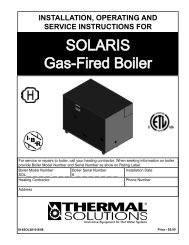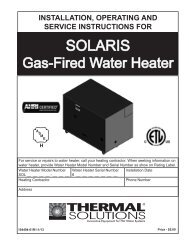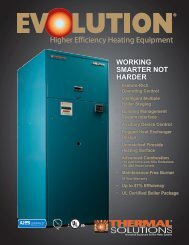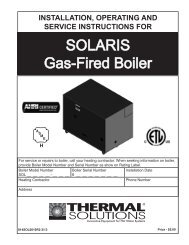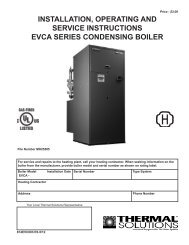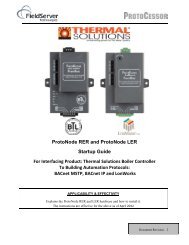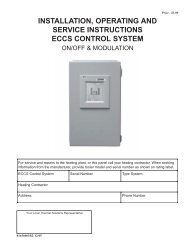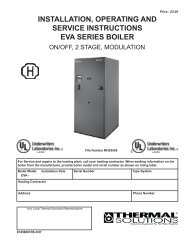I&O Manual - EVCA - Categories On Thermal Solutions Products LLC
I&O Manual - EVCA - Categories On Thermal Solutions Products LLC
I&O Manual - EVCA - Categories On Thermal Solutions Products LLC
You also want an ePaper? Increase the reach of your titles
YUMPU automatically turns print PDFs into web optimized ePapers that Google loves.
WARNING<br />
The maximum operating pressure of this boiler<br />
is 160 psig. Never exceed this pressure. This<br />
boiler was supplied with a safety relief valve with<br />
a pressure relief setting specified at the time of<br />
purchase. The relief valve setting must be above<br />
the maximum operating pressure of the system.<br />
Consult <strong>Thermal</strong> <strong>Solutions</strong> if the desired system<br />
operating pressure is above the safety relief<br />
valve pressure setting. Do not plug or change<br />
safety relief valve.<br />
C. Power the boiler - Turn on electrical supply to the<br />
boiler and circulation system at fused disconnect<br />
switches. Note that there is electrical power at certain<br />
components even with the power switch off. See wiring<br />
diagrams in Figures 9a-9f.<br />
D. Power the Circulators - Turn system circulators on<br />
and purge air from the boiler and system piping.<br />
1. Confirm motor rotation on boiler and system<br />
circulators.<br />
2. Confirm that water flow switch is operating properly.<br />
E. Pressurize the Fuel System - Turn on gas supply to the<br />
boiler gas piping.<br />
1. Confirm that the supply pressure to the gas regulator<br />
supplied with the boiler conforms to Table 2 for<br />
maximum and minimum supply pressures.<br />
2. Open the manual gas shut-off valves located<br />
upstream of the gas regulator supplied with the<br />
boiler. Do not open manual gas valve inside of boiler<br />
jacket.<br />
DANGER<br />
Do not use matches, candles, open flames or<br />
other ignition source to check for leaks.<br />
3. Using soap solution, or similar non-combustible<br />
solution, electronic leak detector or other approved<br />
method, check that boiler gas piping valves,<br />
regulators and all other components are leak free.<br />
Eliminate any leaks.<br />
4. Purge gas line of air.<br />
5. Reset low gas pressure safety switch.<br />
F. Select Operational Mode - Refer to the <strong>Thermal</strong><br />
<strong>Solutions</strong> Boiler Control TM (TSBC TM ) Instruction<br />
<strong>Manual</strong> to select the desired control features.<br />
G. Check Blower Rotation - Remove air filter to expose<br />
the fan blades.<br />
1. Allow boiler to enter the sequence of operation.<br />
2. While in Pre-Purge, position the flame control to the<br />
42<br />
test position.<br />
3. Confirm proper blower motor rotation.<br />
4. Shut boiler off and position the flame control back to<br />
run. Reinstall air filter.<br />
H. Flame Safeguard Operation Check - Turn boiler<br />
operating switch to the ON position.<br />
1. Allow boiler to complete prepurge and trial for<br />
ignition period. <strong>On</strong>ce pilot flame is recognized by<br />
controller, position flame control switch to TEST<br />
position.<br />
2. Look through the boiler sight glass and confirm<br />
that pilot flame is blue and steady and that the flame<br />
signal is steady and between 1.5 and 5.0 volts DC.<br />
<strong>On</strong> some boiler sizes, the pilot flame may not be<br />
visible. In these cases, confirm proper flame signal<br />
(as indicated above.)<br />
3. Adjust pilot gas regulator until proper pilot manifold<br />
gas pressure is achieved per firetest report label.<br />
Pilot flame should be blue with very little yellow.<br />
4. Turn the boiler off, place flame control switch in<br />
"run" position, and repeat Steps H.1 and H.2 at least<br />
five times until reliable pilot ignition and signal is<br />
achieved and confirmed.<br />
5. With the pilot operating properly, allow boiler to<br />
continue to trial for main flame. Confirm that the<br />
flame control locks out on main flame failure.<br />
6. Open the manual main gas shut-off valve located<br />
inside the boiler jacket. Using the procedure detailed<br />
in Step E.3, leak test gas piping and valves inside of<br />
jacket. Eliminate any leaks.<br />
7. Reset flame safeguard and allow boiler to run<br />
through prepurge, trial for pilot and trial for main<br />
flame.<br />
8. Confirm that main flame ignites smoothly.<br />
9. Observe main flame and confirm that burner<br />
element is evenly orange without flickering.<br />
10. Observe flame signal and confirm signal is steady<br />
and between 1.5 and 5.0 volts DC.<br />
11. Using the procedure detailed in step E.3, leak test<br />
gas piping and valves inside of jacket. Eliminate any<br />
leaks.<br />
12. Turn boiler off and repeat Steps H.7-H.10 at least<br />
five times to confirm proper main burner operation.<br />
I. Begin Commissioning the boiler - With main flame<br />
on, at high fire, measure gas pressure upstream and<br />
downstream of the main gas valves<br />
1. Adjust the manifold pressure to match the pressure<br />
indicated on the factory firetest label.<br />
2. Reassure that the inlet gas pressure is within the<br />
acceptable range found in Table 2. Adjust if<br />
necessary.



